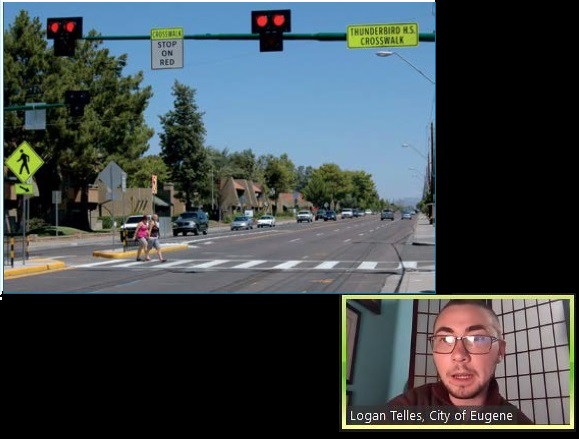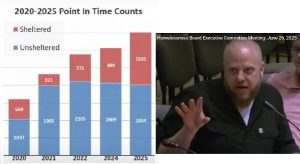River Road backs city bid for protected bike lanes, safer crossings
6 min read
With vehicles not even yielding for flashing beacon lights, the River Road Community Organization hears city plans to seek a ‘Safe Streets’ grant. At the RRCO general meeting Sept. 12:
[00:00:12] Logan Telles: Hi, everyone. My name’s Logan Telles. I’m a transportation planner with the City of Eugene. And I’m here to talk to you about asking for a letter of support for a grant application we’d like to put in that would potentially support some safety improvements on River Road.
[00:00:26] There’s a new, exciting federal funding source called ‘Safe Streets and Roads for All.’ This is the first year the grant’s up for cities to apply for. And it’s going to be a new $1 billion in annual funding from the federal government from 2022 through 2026.
[00:00:40] We have the ability to apply for implementation funding for our Vision Zero action plan.
[00:00:45] For anyone who doesn’t know, our Vision Zero action plan looked at nine years of crash data fairly in depth and found River Road to be one of the most challenging locations in town. It’s our second-highest crash street for people biking, our fifth-highest crash street for people walking, and our fifth-highest crash street for people driving, in terms of life-changing injury crashes and fatalities. So we certainly want to fund some safety improvements along the corridor. This grant opportunity presents an exciting possibility for us to get some improvements out there.
[00:01:17] We would like to include protected bike lanes. That’s the primary piece. We are thinking for the purposes of the cost estimate and planning out our application: a six-foot-wide bike lane with a two-foot-wide buffer and some concrete-protected separators to make that bike space feel a bit more comfortable for people.
[00:01:35] We’re also including green pavement colorant at conflict points to help visually highlight where cyclists are going to be crossing motor vehicle traffic, potentially.
[00:01:45] In addition to the protected bike facility, we’re hoping to get some pedestrian hybrid beacons funded. For anyone who doesn’t know pedestrian hybrid beacons, I’m sure many of you are aware of those lower-to-the-ground RRFB crossings that we have on River Road.
[00:02:00] John Q: (RRFB stands for Rectangular Rapid Flashing Beacons.)
[00:02:06] Logan Telles: Pedestrian hybrid beacons are taller. They’re like the height of a traffic signal. They’re a bit different. A pedestrian would hit the button and it would be able to produce something more like a red phase. We have a few of them on Franklin for anyone who is trying to visualize what exactly I’m talking about.
[00:02:22] We think getting that additional height opposed to the lower-level RRFBs that we have out there now, is something that’s going to help drivers see from further away that pedestrians are entering into a crosswalk.
[00:02:34] And also we’ve heard from some folks who currently use RRFBs on River Road, that they don’t always produce the yielding effect that we would ideally like to see.
[00:02:43] So something taller like a pedestrian hybrid beacon may be a bit more effective at producing that yield compliance. Those pedestrian hybrid beacon crossings would come with a center pedestrian refuge island, so there’s a more comfortable, protected space in the center for people to pause if they need to.
[00:02:59] And additionally we’d like to fund lighting improvements along with these bicycle and pedestrian facility improvements. So in-filling street lighting gaps, where there are street lighting gaps, and also we’d like to be able to upgrade existing street lights to LEDs, for a number of reasons. One, they’re more energy-efficient, and two, it’s just a bit easier to control where the light’s being directed with an LED, opposed to some of the older streetlight technology that we have out there now. So you’re targeting the light a bit better and you’re losing less to light pollution out, above, and away from the area you’re trying to illuminate.
[00:03:39] John Q: The first comment and question came from Dan Isaacson.
[00:03:42] Daniel Isaacson: There’s some technology over in Europe, that was actually pretty—I thought—pretty amazing. It’s a simple switch that hooks in with the LED so that when you press the button to do the crosswalk, the entire streetlights above it increase their brightness by 25%. So the entire entranceway becomes very bright.
[00:04:02] But the question I have is: Do you have an update on the crossing at Hatton and where we’re at in that process?
[00:04:07] Logan Telles: Yeah. I emailed the engineering project manager about that yesterday. I’m hoping to hear back soon about the new estimate for when we can get to that. Jolene, I think you were next.
[00:04:20] Jolene Siemsen: Hi, thank you. Two things. One is, can we get the speed limit on River Road lowered to 30 miles per hour, which would also place all these safety improvements in line with Vision Zero data regarding severity of injury. So I know you can’t even probably answer that now, but I feel like that’s essential to all these other improvements.
[00:04:43] And the other is: Can you partner with the county so that some of our other streets that are county-governed also can see some improvements in terms of things like complete street design, green, green painting to allow for safer pedestrian and cyclist connectors to River Road. That’s all. Thanks.
[00:05:08] Logan Telles: Sure. To briefly answer your first question about the speed limit: The state of Oregon regulates the process by which speed limits can be set. There have been some very recent rule changes that have gone into effect, so we are doing a bit of internal evaluation on what that means for us, and what that means for what types of speed limit reductions we might pursue in the future. I don’t have an immediate answer for River Road, but that is something that I can talk to our traffic engineer about and we can figure out whether that’s something we feel we would be successful in.
[00:05:37] And then for your second question about the county, this new funding opportunity is also something that would be available to them. And I’m hopeful that they will put in an application. That’s certainly something I can talk with them about and see if maybe there’s potential for us to coordinate in the future. Because, as I mentioned, this grant is going to continue over subsequent years and it’s going to be a really important funding opportunity for both this project here, potentially, and future projects that we want to go for.
[00:06:08] Brent Reed: Logan, thanks for coming. I like the idea of the crosswalks and I think we would all appreciate as many crosswalks as possible on River Road to help slow down the traffic and the bike lanes are very interesting ideas. My question is: How will these bike lanes meld or mesh with the potential for the ‘Move Ahead’ project? so if the bike lanes are already going to be built, For the portion of the ‘Move Ahead’ project from Maxwell to Park, is that a double funding project? Just a question I had.
[00:06:40] Logan Telles: Sure. Yeah. To try answering your question briefly: At this stage in the process, we don’t have to resolve the detailed design questions about how the protected bike facility would interact with transit. At this point, we’re just trying to secure the funding.
[00:06:55] And one, if we received the grant award, we would need to use it within five years. So we would have time to coordinate with LTD and make sure we’re coming up with a good design solution for how we’re managing any potential bike and bus conflicts.
[00:07:11] John Q: Moving along to the vote, RRCO Co-chair Jon Belcher.
[00:07:15] Jon Belcher: I move that we send a letter of support for the projects mentioned earlier by Logan.
[00:07:23] John Q: Eligible voters under RRCO’s rules made their choices known.
[00:07:27] Jon Belcher: The vote has stabilized. It is 19 ‘For’ and two ‘Against’, so we will send the letter of support to the city for this proposed project.
[00:07:36] John Q: A potential new funding source to improve safety, on one of Eugene’s most dangerous streets for people walking and biking.




